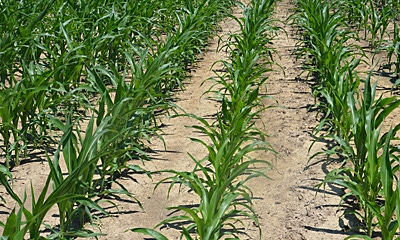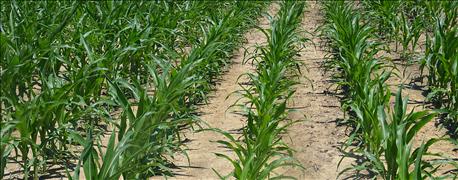June 23, 2016

As the summer heat rolls in, we’re seeing cornfields grow at extremely fast rates. This is when we get to sit back and watch our hard work grow, right? Now is definitely not a time to skip out on scouting. Here are four things we are watching.
1. Are cornfields really going backward?
Many cornfields have looked great, but now seem to be going backward. We’re still fighting some effects of soil compaction from planters, and in a few cases, from vertical-tillage tools that were run to dry out wet soils. Rain has helped a few of these fields get through the compaction layers, but some could struggle all year. These fields are also showing signs of nutrient deficiencies.

UNEVEN CORN: Soil compaction may be holding back certain rows or portions of rows within the field.
Take time to pull tissue tests and find out what the concerns are. Compare the results with your soil test. Are the nutrients present in the soil, but the roots are unable to get them? If the soil test is also low or deficient, make changes to your fertilizer program to help supplement the crop. A common deficiency this spring has been sulfur. We could still add that during sidedress time.
2. Insect pressure is building.
In corn, be looking for insects. We’ve seen the first generation of corn borer arrive by the hole shots in leaves where they fed through the whorl. We’re also still seeing a few cases of armyworms. In soybeans, be looking for bean leaf beetle damage. Insect levels have been low so far, but we want to stay ahead of them before they do too much damage.
3. Herbicide concerns are real.
With planting being spread out over a long period, be sure to check height and growth stage restrictions on your herbicides before spraying. In soybeans, we also need to be aware of carryover and plant-back restrictions for 2017. For example, if you’re looking at using Flexstar (fomesafen), it has a 10-month plant-back to corn.
Many of you are using cover crops in your system. Be aware of residual products that may affect your cover crop establishment this fall. We want to get the best weed control possible, so we may need to change a few things in our cover crop mix.
4. Check soybean populations for double-cropping.
As we move through June and into double-crop soybeans for the southern part of the state, continue to increase your planting populations on soybeans. This helps increase plant height and moves pods up higher on the plant for easier harvest. The higher population will also help ge a faster canopy for weed control.
Gauck is a team sales agronomist with Beck’s. He writes from Decatur County.
You May Also Like




